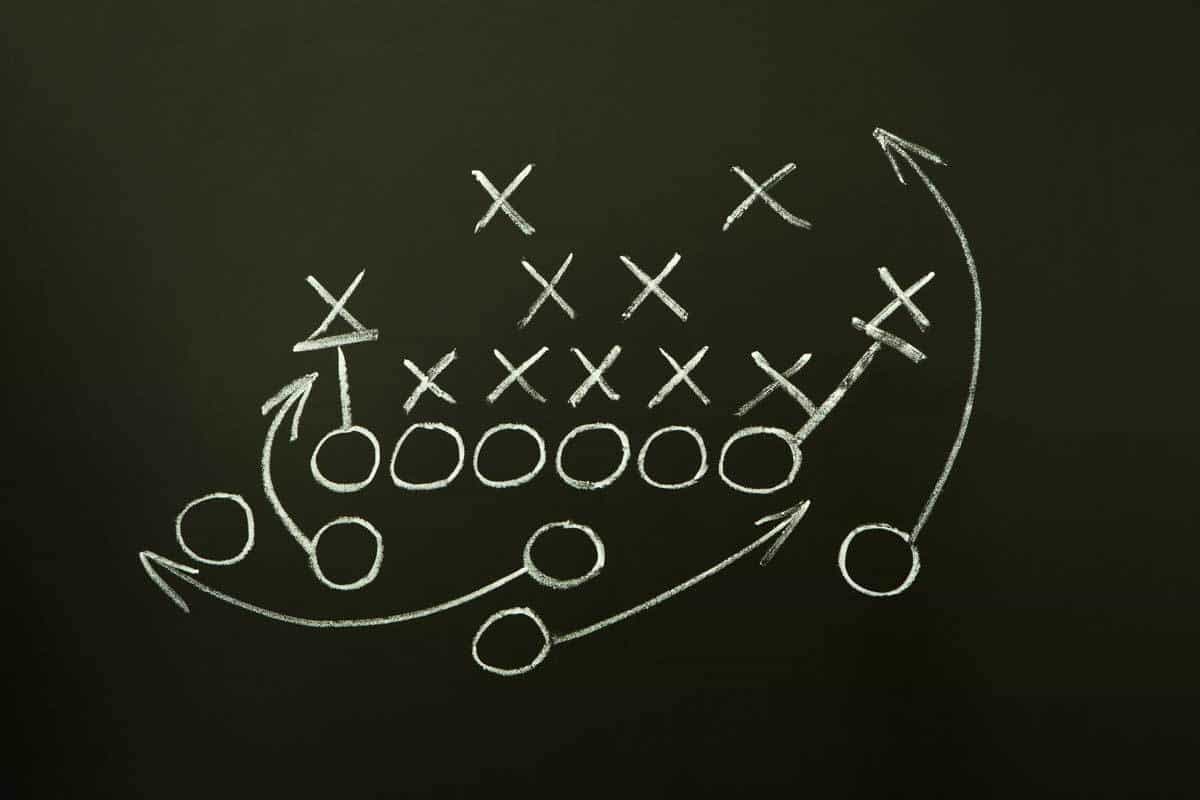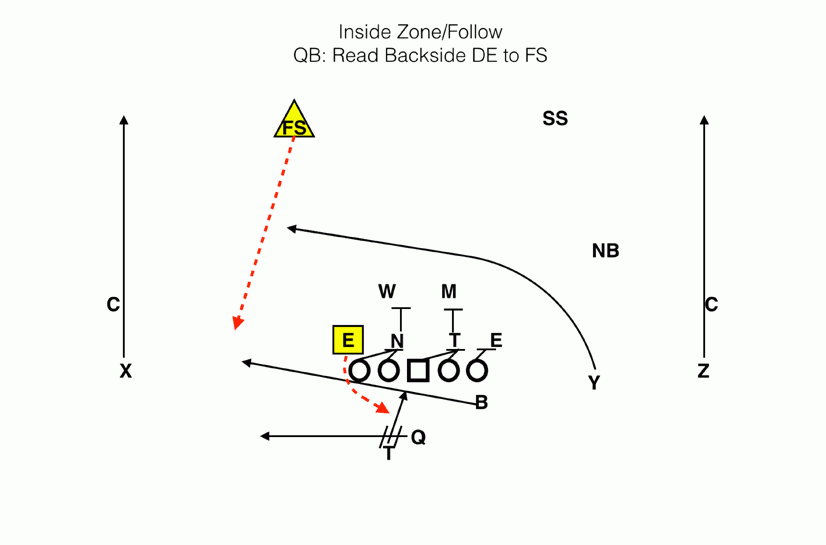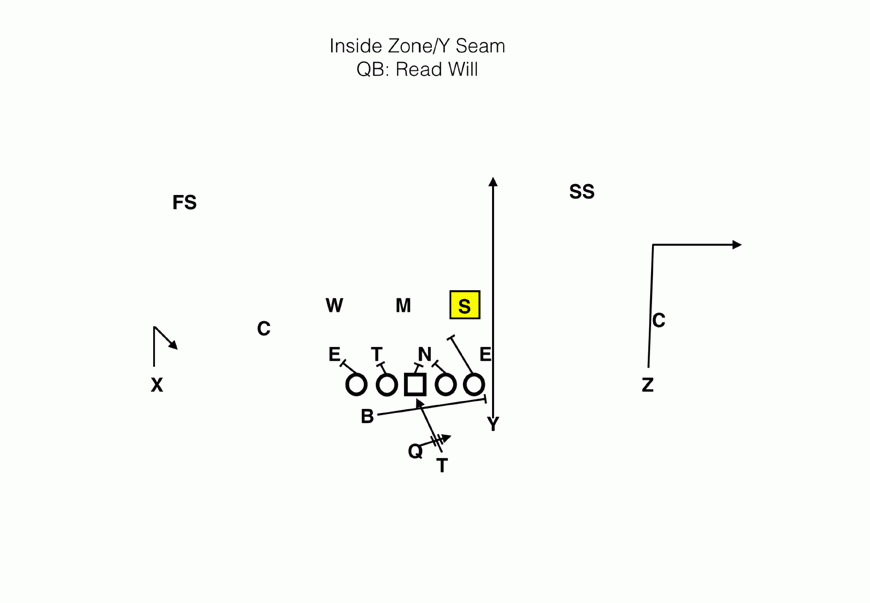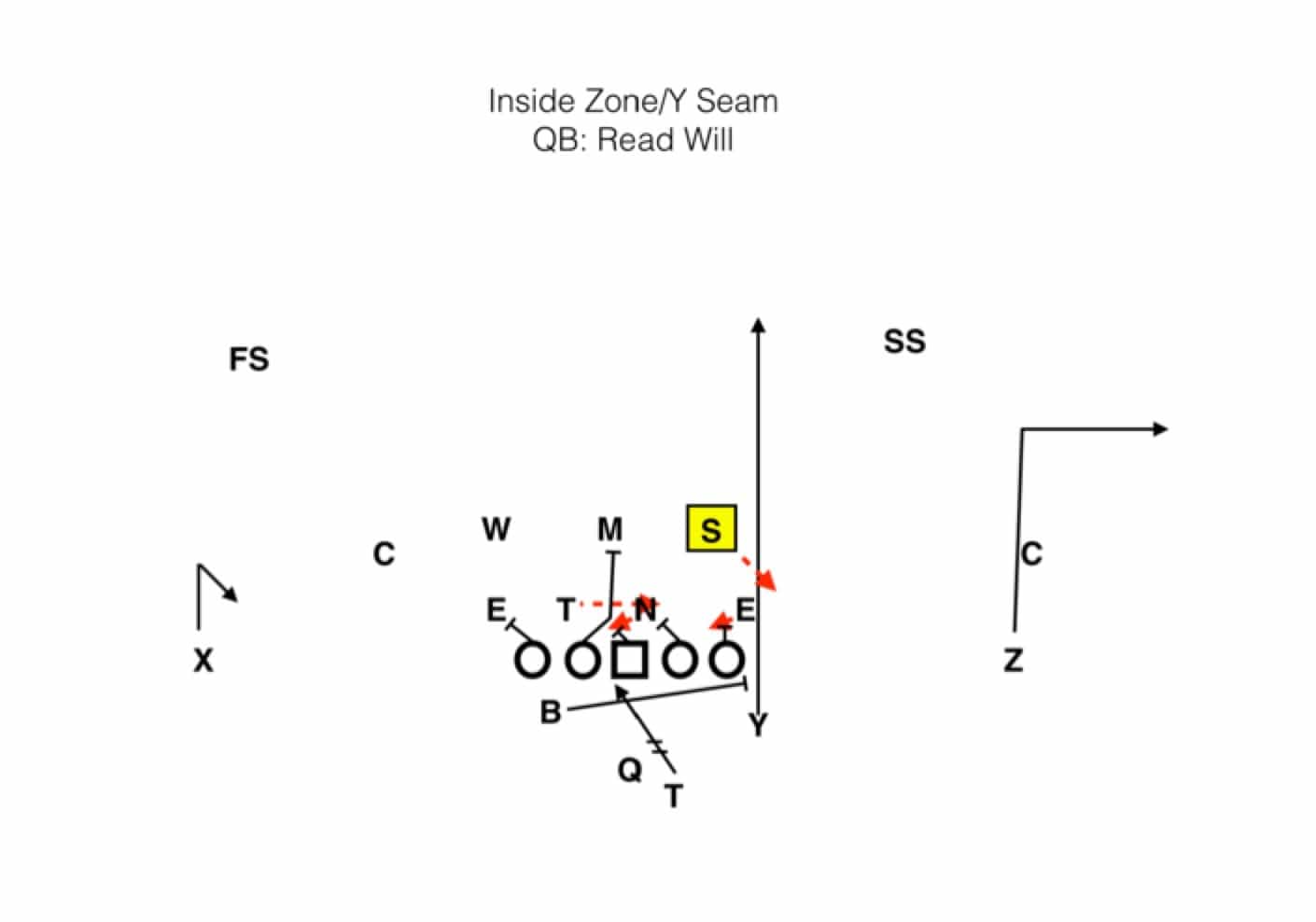Now that we’ve laid some foundation for optioning defenders, spread running games, and packaged plays, it’s time to get to the meat and potatoes and tie this series into the Gator offense that we’ll be running under Kurt Roper’s direction this season. While you’ll see several familiar concepts, what you should notice is that, like all great coordinators, Roper brings his own twists to these concepts based on what he is trying to accomplish.
We’ll start by taking a look at a play based of the standard inside zone read that was featured both by Roper’s Duke team last year and heavily in the Orange and Blue game this spring:

Essentially, this is a variation on the follow concept where you have a high/low stretch with a dig following a drag. Roper keeps the throw shorter and has a drag following a flat pattern underneath the formation. Take a look at how it breaks down below:
What is happening here is that the progression for the quarterback is being reduced down to two very simple one-man reads. First, the end man on the line of scrimmage on the weakside (in this case the defensive end) is being read to determine whether to the quarterback will give the ball to the tailback or keep the ball, and second, the weakside force player (in this case, the free safety) is being read to determine whether the quarterback will throw to the slot receiver (Y) or the B-back (B). It’s also a roll-out play where the quarterback can take off in the event the Y receiver gets walled off or the end ends up pinching the B-back and preventing his release. Of note, though is that there are options for the quarterback and that it’s a play designed to try to get the ball out of his hands rather than force him to take a hit. We’ll see that theme continue as we move on to the next play.

This one is a particular favorite of mine. It’s a combination of a variation on the inverted veer/QB dash along with a quick hitting 4-verticals with the B-back wheeling out of the backfield and putting tremendous stress on the strong side force defender. Where it gets interesting is how Roper tweaks the play to keep the quarterback upright. When drawn up, it looks something like this:
What I like about this play is that rather than asking the QB to read the playside end and then have to run the dive through the interior of the defense if the end takes the tailback as in a traditional inverted veer, Roper pulls the backside guard to kick out the end. This provides more support to the sweep action of the tailback and protection for the QB in the event he pulls the ball to pass. The QB’s read is then isolated in this case to the strong safety. If the safety comes up to play the run, there is no way he can cover the B-back wheeling out vertically. The QB will then pull it and have a wide open B-back (Think Matt Jones, Hunter Joyer, or Jake McGee) running up the seam at 12-15 yards downhill with a safety to beat. If the safety stays back and doesn’t let the B-back behind him, then the B-back turns into a blocker, the quarterback gives, and the only person who can make the play is the Will linebacker coming from the other side of the field through traffic or the free safety many yards downfield.
One last play we’ll look at today is another one based on inside zone but designed to bind the backside force defender. It’s also done from a somewhat non-spread formation, with 3 men in the backfield in addition to the quarterback and 2 split receivers.

This play is a simple seam route by the tight end that is in this case attacking the Will Linebacker stemming off of an inside zone play with the B-back tagged to come across underneath the formation and kick out the end.
On this play, the QB reads the Sam Linebacker, due to the width of the strong safety being outside the hash and thus unable to help up the seam or play run support. If the Sam does anything but bail out to run with the Tight End (Y), the QB is going to pull the ball from the tailback and hit the tight end up the seam. If the Will bails out, there are still numbers in the box to block the run game for a positive play.
What I’d also like to point out is how the zone blocking scheme from Duke deals with the stunts the Aggies’ defense throws at them. Anticipating a zone read, the Aggies actually run a sort of scrape exchange with the strong side end crashing inside and the Sam linebacker playing the keeper. The Nose and 3-technique also run a stunt with the nose going first and slanting into the A-gap on the opposite side of the center and the 3-technique twisting behind him. This type of stunt tripped up our OL many times last year, but Duke’s OL is able to respond to it.

Note how the three interior offensive linemen work together to pick up the twist. Here’s how the assignments change as a result of the stunts:
As soon as the nose slants across the center’s face, the strongside guard immediately is looking for someone coming behind him to pick up, finding the nose tackle. Similarly, the weakside guard notes the lineman covering him twisting across his face and immediately looks to assist the center on a combination block of the nose tackle. Similarly, the strongside tackle locks down the end on the scrape exchange when he pinches down. Had this play been a keep and run zone read by the QB, the pulling B-back would have had no problem picking up the Sam linebacker with the C-gap/contain assignment and freeing the QB for big yardage.
By now, you should be able to see how modern spread offenses are bringing a new brand of option football to the gridiron, and how Kurt Roper plans to do exactly that for the Gator offense with his own twists and wrinkles. I, for one, can’t wait to see what other packaged plays and unique variations will be unleashed on Gator opponents this year. If one thing is for sure, this offense will be the best fit to the talent we have since Muschamp arrived. Combine that with our standard stellar defense and I think we’ll see some significant progress come August 30.







Great breakdown of the plays! With our athletes running this type of O and it being “up-tempo” we should give teams fits once they get to the point of reacting vs thinking.